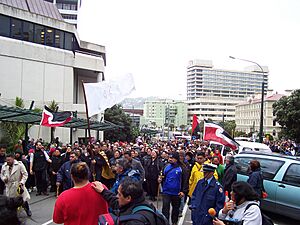Hīkoi facts for kids

A hīkoi is a special kind of walk or march, usually a protest march, that happens in New Zealand. The word comes from the Māori language, the native language of New Zealand. A hīkoi often means a long journey that can take many days or even weeks. It's a way for people to show what they believe in and to bring attention to important issues.
Contents
Famous Hīkoi Marches
The 1975 Māori Land March
One of the most famous hīkoi marches was the 1975 Māori Land March. This march was organized by a respected Māori leader named Whina Cooper. Supporters and protestors walked the entire length of the North Island of New Zealand. They started in a place called Te Hāpua and walked all the way to the Parliament building in Wellington. This hīkoi was about protecting Māori land rights.
The 2004 Foreshore and Seabed Hīkoi
In 2004, another big hīkoi took place. This one was during a time when there was a lot of discussion about who owned New Zealand's coastline, including the beaches and the sea close to shore. This was called the Foreshore and seabed controversy. Many people were against the government taking control of these areas. Marchers walked through cities and towns, and some travelled in vehicles in country areas, all to show their opposition.
The 2009 Auckland Hīkoi
On May 25, 2009, between 500 and 700 people took part in a hīkoi in Auckland. This march happened because the government had suggested that the new Auckland Council, which was being created for the city, might not include special seats for Māori people. The hīkoi was a way for people to protest this idea and ask for Māori representation in the council.
The 2024 Hīkoi for the Treaty
In November 2024, a large hīkoi called hīkoi mō te Tiriti happened. This march was against a proposed law called the Treaty Principles Bill. This bill aimed to change how the Treaty of Waitangi is understood and used in New Zealand law. An estimated 42,000 people joined this hīkoi. It took nine days for them to reach the Parliament grounds in Wellington. Some groups started their journey from the very far north of New Zealand, in the Far North District, and others from the very south, in Bluff, New Zealand. The Māori Queen, Ngā Wai Hono i te Pō, even joined the protestors in Wellington. At the same time as the march, an online petition against the bill gathered over 200,000 signatures.
See also
- Māori protest movement

